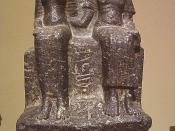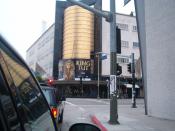Sarah Livingston
Art History 110
February 3, 2014
The third floor of the Los Angeles County Museum of Art houses a permanent collection on Ancient Egyptian art. One of the pieces there is a 13" high figurine of the goddess Wadjet, sculpted from bronze in during the 26th Dynasty, est. 664-525 BCE. The figurine is in the round, with only the goddess's feet attached the rectangular base she stands on. The hieroglyphs on the base identify her, as well as the name and parentage of the person who dedicated her figurine. She is shown in the traditional ancient Egyptian pose, with her left foot forward. She is wearing some sort of dress, but her decidedly feminine figure, with a curved abdomen, narrow waist, and protruding breasts, is clearly portrayed through it. Her right arm is held rigidly at her side, again in strict stylistic convention, and her left arm bends only at the elbow to hold whatever less enduring material was placed there.
In fact, both of her hands were clearly intended to encircle props, but these have been lost and as such, what they once were can only be inferred from other portrayals of the goddess. She clearly wears necklaces, armbands, and bracelets; this highly detailed work is also present on her lion's mane, which is shaped similarly to the pharoah's headdress. She has the head of a lioness, upon which rests the sacred cobra and sun disk, called the uraeus.
The goddess Wadjet was emblematic of Lower Egypt- she was often portrayed with her counterpart in Upper Egypt, Nekhbet, handing their joint power to the pharaoh of the time. Other than those human depictions, she was usually shown as a cobra, which allows this piece to be dated- she was only pictured with...


